| |||||||
| Search Forums |
| Advanced Search |
| Go to Page... |
 |
| Search this Thread |  73,797 views |
| | #1 |
| Distinguished - BHPian  Join Date: Aug 2014 Location: Delhi-NCR
Posts: 4,074
Thanked: 64,384 Times
| Indian Aviation - Hawker Seahawk with the Indian Navy Hawker Seahawk with the Indian Navy This is the story of the Hawker Seahawk and its service with the Indian Navy through the 1960s and 1970s and the aircraft's role in developing naval carrier aviation in the Navy's fledgling years and its role in the December 1971 Indo-Pak war. The article will touch upon INS Vikrant (which is a delightful story by itself), the Navy's first carrier, only to the extent relevant to the context of the Seahawk story. Note: Data and anecdotes in this article have been sourced from the reference books mentioned at the end (from my personal library). A word of thanks to the excellent book Down Wind, Four Green by Vice Admiral Vinod Pasricha (Retd) which is the definitive book on both the Seahawk in Indian service and the early years of carrier aviation in India. Portions taken from this book are marked 'Source $$'. I. Acquiring a light carrier In the mid-1950s the Indian Navy sought to build a small carrier force through the acquisition of one light aircraft carrier. The budget brahmins in Delhi did not agree. In the mid-1950s a half completed British carrier HMS Hercules came up for sale off the stocks (ie production line) because the Royal Navy budget cuts did not provide for her. The Navy was keen, Pandit Nehru was undecided and the budget boys were against it. Lord Louis Mountbatten then Chief of the Royal Navy advised Nehru that without a carrier our Navy wouldn't amount for much and it takes a generation to develop carrier operating capabilities and this chance may not come again soon (and how right he was about that *). Nehru being the visionary he was decided for the motion. HMS Hercules had been laid down in 1943 during World War II and was 75% complete when the war ended and had been put into preservation, incomplete, as she was no longer needed. She (a naval ship is always a she, never an it), along with 3 sister ships, was kept in preservation pending a decision on completing her for service with the British and their allies. In this context after British budget cuts in the 1950s these three were sold to the Canadian, Australian and Indian navies after being completed and modernized. HMS Hercules was bought by India in 1957 and started to get fitted out. Opportunity was taken to equip the ship with modern carrier developments that had taken place since World War II, which were an angled flight deck, mirror deck landing sights and a steam catapult (more on these later in section VI). She commissioned into the Indian Navy in 1961. INS Vikrant was 704 feet long and had a flight deck width of 128 feet at its widest. Its landing deck was angled ~8 degrees to the left of the centreline enabling the rear half to be used for landings and the fore half for take-offs (although not simultaneously). She displaced ~19,500 tonnes at full load and steamed at 24.5 knots (max) or 23 knots (sustained) at a full power of 40,000 shp. A knot is 1 nautical mile per hour ~ 1.85 kmph. She was sized to carry a complement of 21 of the medium sized aircraft of those days and could steam ~6000 nautical miles (~11,000 km) at full speed or ~12,000 nautical miles (~22,000 km) at a slow cruise of 14 knots (~26 kmph). See P1 for a fine view of Vikrant's characteristics. * Carriers are strategic weapons of deterrence and normally countries don’t sell carriers except to their closest allies. Vikrant was the last of the incomplete WW2 carriers to be sold. Since 1961 there are only 6 instances of a carrier being sold from one country to another, two of which were to India (INS Viraat from the UK & INS Vikramaditya from Russia). 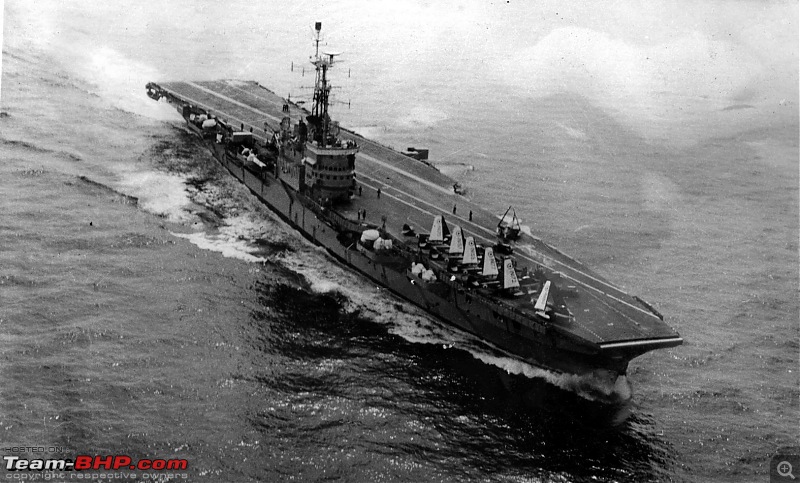 INS Vikrant (pennant R11, deck sign 'W') . Aircraft parking forward starboard (right); catapult launch area forward port (left); landing flight deck aft (rear) angled at 8 degrees to the centreline; island for control of ship & aircraft flushed right. Source ## II. Enter, the Seahawk The Indian Navy needed to select a light naval fighter bomber from the types available with the British or the French. The Americans who operated the biggest carrier fleet (then & now) were not inclined to sell their machines given our non-aligned stance. Vikrant was fitted with a short stroke steam catapult (ie lower powered one) that is used for launching aircraft into the air from a short ~200 feet run. India wanted a long stroke steam catapult (ie higher powered one) which the British refused point blank with a crisp statement that the Indians need to learn to walk first before they can run! This limited our choice to basically the Hawker Seahawk from the UK and the excellent but inaccessible American Douglas Skyhawk from USA. So we went with the British Seahawk. The French Dassault Etendard was evaluated but could not be launched at full weight with a short catapult. P2 shows the streamlined shape of the Seahawk. In all fairness it must be said that the officers of the Royal Navy who were entrusted with training the Indian crew threw their heart and soul into the task and did a lot to have us learn how to operate, repair and fight with aircraft at sea. This instruction and training has been invaluable and formed the foundation on which the Navy's carrier capabilities continue till today. In May 1961 Lieutenant Commander RH Tahiliani made the first ever landing at sea on INS Vikrant thus starting the era of carrier aviation in India. See photos P3 and P4. Tahiliani later went on to be the Naval Chief in the 1980s. India procured a mix of new built and refurbished ex-UK Seahawks to arm its first naval fighter squadron INAS 300 White Tigers - named for the famous white tiger of Rewa (Photo P5). In the 1960s a typical complement on Vikrant would be 12 to 16 Seahawks along with 4 to 8 Bregeut Alize ASW (anti-submarine warfare) & reconnaissance aircraft and 1 Alouette helicopter for air to sea rescue and utility jobs. 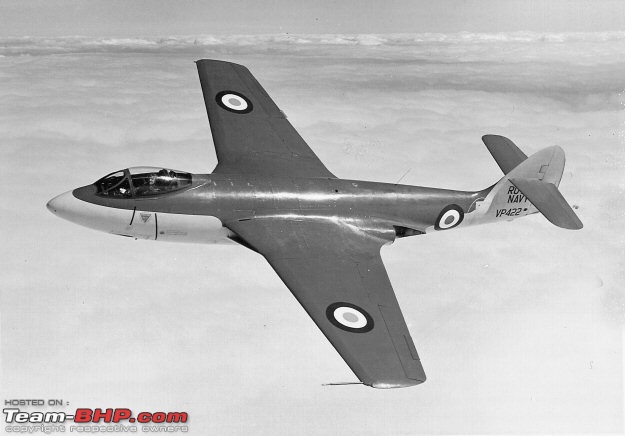 Hawker Sea Hawk, 1953. Note clean lines and streamlined shape, blending of wing with airframe, all round view from cockpit view from cockpit 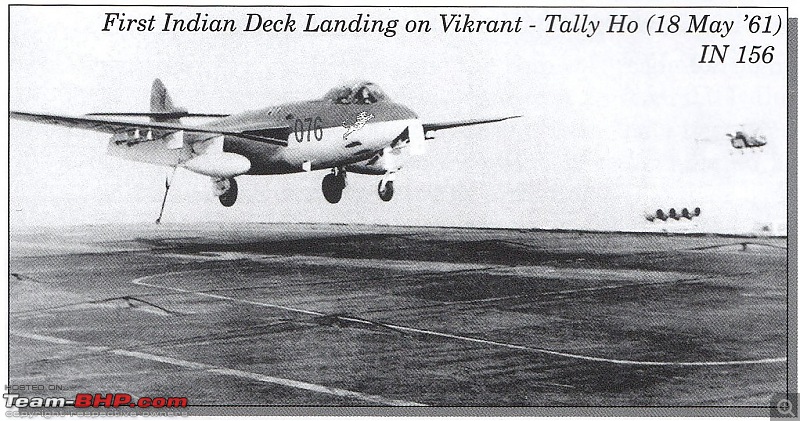 First ever landing on INS Vikrant - by Lieutenant RH Tahiliani, call sign 'Tally Ho' and later first pilot to rise to be the Naval Chief. The number IN156 is like the chassis number while the 076 painted on the nose is like your car's registration number. Source $$ 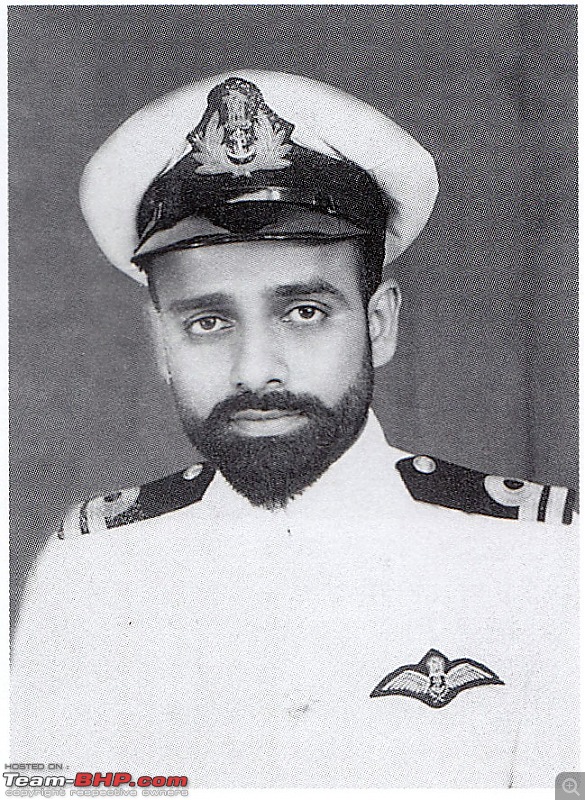 Tally Ho as a young Lieutenant, 1950s. Commanded Vikrant in 1970s and led the Navy from 1984 to1987. Father of fashion guru Tarun Tahiliani Source $$ 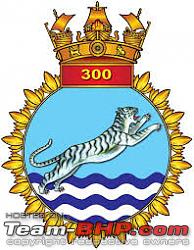 Crest of INAS 300 White Tigers. III. Seahawk, the aircraft The Seahawk was a single engine, straight wing (ie not swept back) streamlined design with wings set at mid-frame. As seen in photo P2 it had a clean smooth design. Being a naval aircraft it had folding wings that folded up just outside the air intakes (see photo P6) to reduce the deck footprint and thus accommodate more aircraft within the confines of a hangar below decks. The Rolls Royce Nene turbojet engine was mounted in the fuselage centre fed by air intakes on the sides and with the exhaust (which propels the jet along) bifurcated into left and right tail pipes. This unique configuration of bifurcated tailpipes allowed better centre of gravity envelope with mid-mounted engine, fuel tanks in the wings (also mounted in the centre) and fuel tanks forward & behind the engine balanced each other thus also contributing to maintaining the C of G as the machine burned through its fuel. Photos P8 and P9 show these characteristics to good effect. Photo P8a shows the contours of the Nene powerplant. Note the wire mesh to filter out debris from getting sucked into the engine. The pilot sat right up front under a bubble canopy that gave him unrestricted almost 360 degree view and a good view straight down too. The avionics (aviation electronics) were simple even for the time - no radar, no guided missiles and navigation by mental maths. It sported an arrestor hook under the tail that was deployed to snag the arrestor wires strung across the carrier deck to halt the aircraft on the limited flight deck length (see photo P10). The airframe and landing gear were designed to be much stronger than that of a comparable land based aircraft due to the rigours of deck landings. Carrier landings and take-offs explained in section V below. The Seahawk was designed by the legendary Sir Sydney Camm who also designed the Hawker Hurricane (World War II), Hawker Hunter and the Hawker Harrier jump jet. The first prototype Seahawk flew in 1949 and it served with the Royal Navy from 1953 to 1963 and was blooded in the Anglo-French invasion of the Suez canal in 1956. The aircraft also served with honours with the Dutch Navy onboard HNLMS Karel Doorman, a carrier that was similar to INS Vikrant, till 1964 and with the West German Navy till the mid-1960s. Compared to contemporary aircraft such as the North American Sabre & the Mig-15 the Seahawk was slower, climbed less enthusiastically and was more of a ground attack aircraft than an interceptor. I cannot comment on maneuverability as the occasion to test versus each other never arose. The low wing loading of 48 to 58 lbs/ sq ft would have aided maneuverability but the modest power to weight ratios would have detracted from it. Where it excelled in was in being very stable and trouble free in flight, having long legs relative to the first generation jets and it could carry a reasonable load (for its era) to earn its stripes as a fighter ground attack weapon. 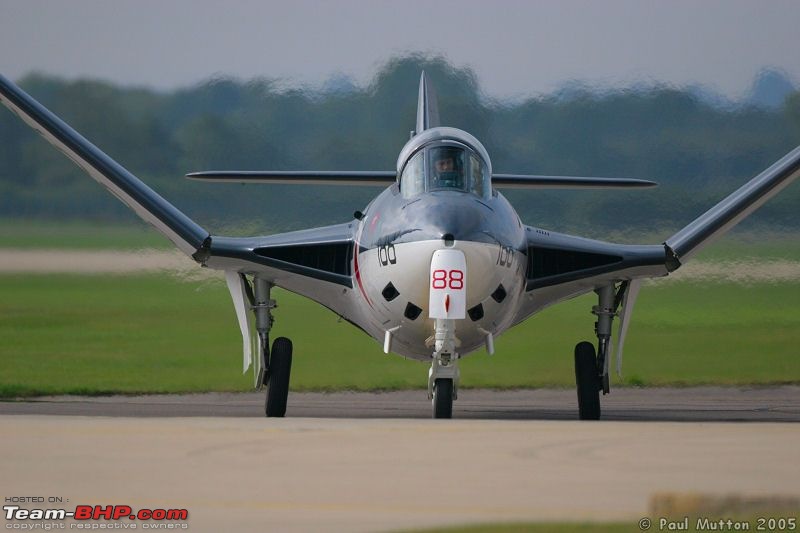 . Wings folding just outside the air intakes reducing significantly the deck foot print of the Seahawk enabling greater numbers to be carried on the carrier 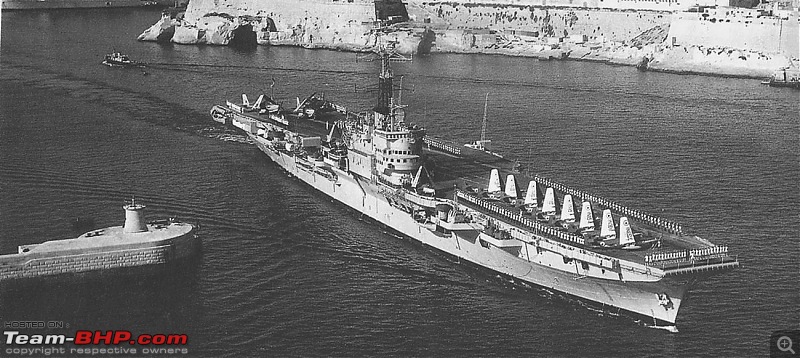 Vikrant entering Malta in the Mediterranean with 8 Seahawks lined up on the foredeck with wings folded. Source $$ 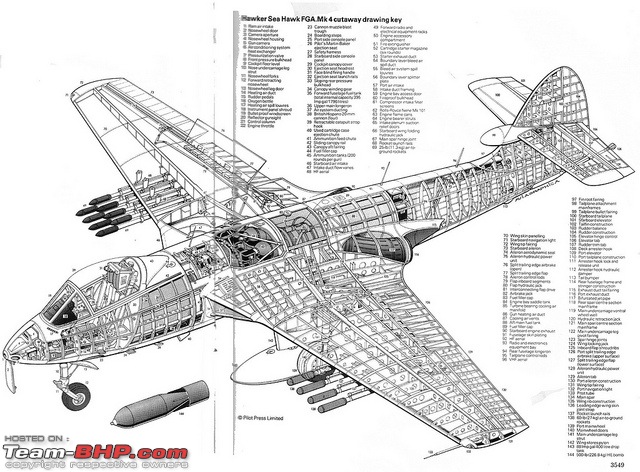 Note engine in centre aiding CG maneuvering envelope, the 8 or 16 air to ground heavy rockets under the unswept wings, the bifurcated engine exhaust pipe unique to this design, the bubble canopy & the long range underwing tanks. Source: Pilot Press 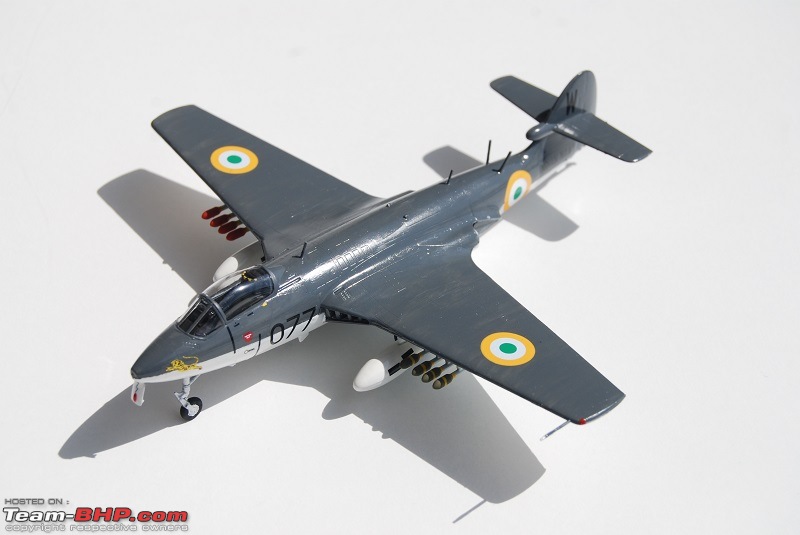 Scale model showing all the features clearly  2 x 20mm cannons visible under cockpit (drop like fairings). Arrestor hook under the tailfin to catch the arrestor cable with. Drop tanks for extended range IV. Technical Data for Seahawk FGA.Mk 6 (Fighter Ground Attack) (all Seahawks acquired by India were either FGA.6 or upgraded to this level or the very similar Mk 100, ex-German) Dimensions Crew: One Length: 39 ft 8 in (12.09 m) Wingspan: 39 ft 0 in (11.89 m)/13 ft 4 in when folded Height: 8 ft 8 in (2.64 m) Wing area: 278 ft² (25.83 m²) Weights Empty weight: 9,720 lbs (4,409 kg) Loaded weight clean: 13,220 lbs (5,996 kg) Max. takeoff weight: 16,200 lbs (7,348 kg) Powerplant Type: 1 × Rolls-Royce Nene 103 turbojet, Thrust: 5,440 lbf (24.03 kN /2467 kgp) at 12300 rpm at sea level Specific fuel consumption: 1.06 lbs/lbf/hour - kitna deti hai? in petrohead terms that is 0.27 kms per litre at full thrust flying clean at altitude!!! Performance Maximum speed: 600 mph (965 km/h) at sea level Range: 420 nm (770 km) w/o drop tanks; 685 nm (1285 km) with underwing drop tanks; Combat radius: 200nm (370 km) with weapons & reserves Service ceiling: 44,500 ft (13,564 m) Rate of climb: 5,700 ft/min (29.0 m/s) Wing loading: 48 lb/ft² (232 kg/m²) clean / 58lbs/ft2 fully loaded {lower the wing loading greater the maneuverability. To make full use of this low loading the fighter must be matched with a high power to weight ratio. Seahawk's 0.38 in clean condition is modest compared to the Gnat's 0.60} Thrust/weight: 0.38 clean [Clean configuration means fully weighed up with all internal payload and fuel but without any external weapons or tanks (typically carried on the wing or centreline pylon] Armament Guns: 4 × 20 mm cannons (200 rounds per gun) in the nose with a high combined rate of fire of ~3000 rounds per minute. Projectile weight 130 grammes. Projective velocity 840 metres/second Hardpoints: 6 underwing and provisions to carry combinations of: Rockets: 20 × "60 lb" (27 kg) unguided rockets or 16 × 5 in (127 mm) unguided rockets Bombs: or 4 × 500 lb (227 kg) bombs Other: or 2 × 410 litre drop tanks India acquired a total of 74 Seahawks from the British and the German navies. These machines operated from Vikrant from 1961 till 1978 and then moved into reserve. Interestingly the second hand (pre-owned, anyone) machines from the British came, in 1961, at a price of $182,000 each with spares extra. In contrast the German navy sold us their machines at ~$25,000 in 1966 with tons of spares included!! Even after adjusting for inflation of the $ this was a steal {In honour of this, just for today, we will not complain of the after sales service of VAG  } Source $$ } Source $$V. Landing & taking off from a carrier Photo P11 shows the deck arrangement of INS Vikrant to good effect. Have a look at it to better understand the techniques of landing and catapulting a Seahawk from the carrier deck. The descriptions below are brief and simple and by no means convey the complexity involved. 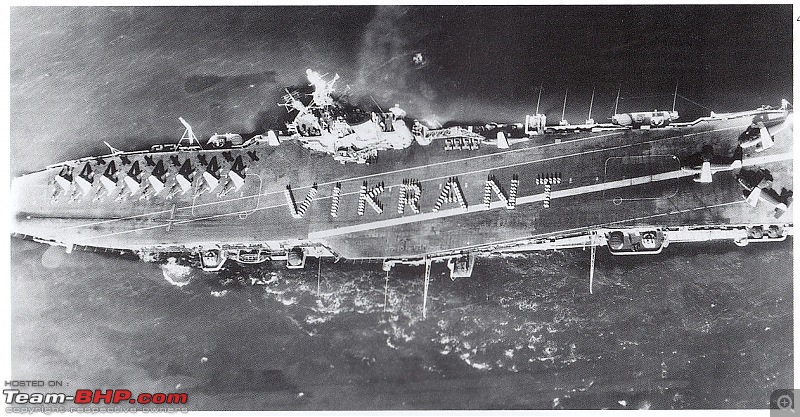 P11. Aerial overview of INS Vikrant's deck. Note - flight landing deck angled at 8 degrees to the left leaving the path clear for an aircraft to take off again in case of a failure to engage the arrestor wires. The steam catapult is the dark rail line on the fore left side. The rectangular deck lifts outlined in white front & rear. The island or control centre is on the right centre of the carrier. the hangar deck ie where the aircrafts are maintained lies under the flight deck. The arrestor wires are strung across the width of the deck close to the rear at approximately where the deck lift on the right of the photo is. Visualize the limited deck foot print of a Seahawk with folded wings. Source $$ First the landing… Landing on a flight deck is one of the most difficult things a naval pilot will ever do. The flight deck on Vikrant had only about 350 feet of runway space for landing planes, which isn't nearly enough for a 7 tonne high-speed jet. To land on the flight deck, each plane needs a arrestor hook, which is exactly what it sounds like -- an extended hook attached to the plane's tail. The pilot's goal is to snag the arrestor hook on one of three arresting wires stretched across the deck and attached on both ends to hydraulic cylinders below deck. If the arrestor hook snags an arresting wire, it pulls the wire out, and the hydraulic cylinder system absorbs the energy to bring the plane to a stop. The arresting wire system can stop a 6000kg aircraft travelling 200 kmph in only two seconds, in a ~300 foot landing area. There are three parallel arresting wires, spaced apart, to expand the target area for the pilot. Pilots aim for the third wire, as it's the safest and most effective target. They never shoot for the first wire because it's dangerously close to the edge of deck. If they come in too low on the first wire, they could easily crash into the stern of the ship. To pull off this incredible trick, the pilot needs to approach the deck at exactly the right angle. The mirror landing sights and the Mirror Control Officer help the pilot land. The mirror landing device is a system of lights and lens whereby if the pilot is on the right glide path he sees an amber light dubbed the "meatball," in line with a row of green lights. If the amber light appears above the green lights, the plane is coming in too high; if the amber light appears below the green lights, the plane is coming in too low. If the plane is coming in way too low, the pilot will see red lights. Photo P12 shows a Seahawk about to snag an arrestor wire. As soon as the plane hits the deck, the pilot will push the engines to full power, instead of slowing down, to bring the plane to a stop. This may seem counterintuitive, but if the arrestor hook doesn't catch any of the arresting wires, the plane needs to be moving fast enough to take off again and come around for another pass. The landing runway is tilted at an 8 degree angle to the rest of the ship, so bolters like this can take off from the side of the ship instead of plowing into the planes on the other end of the deck. As soon as an aircraft lands, it's pulled out of the landing strip and chained down on the side of the flight deck. The difficulty of this is compounded by the fact that the carrier is pitching and rolling while you are trying to land on it and it is constantly moving away from the pilot and his aircraft and the pilot keeps adjusting for this every second on his approach. Think of yourself racing a BMW 5 at 200 kmph down a highway with your arm extended out of the window aiming to grab one of three wires hanging vertically a few feet away on the side of the highway -- now imagine that the highway itself is pitching up and down gently and rolling left to right -- now imagine doing it at night.  Landing an aircraft is a skill of a very high order as every pilot on this forum will agree. Doing it on a carrier deck is taking that skill to its final art form. Landing an aircraft is a skill of a very high order as every pilot on this forum will agree. Doing it on a carrier deck is taking that skill to its final art form.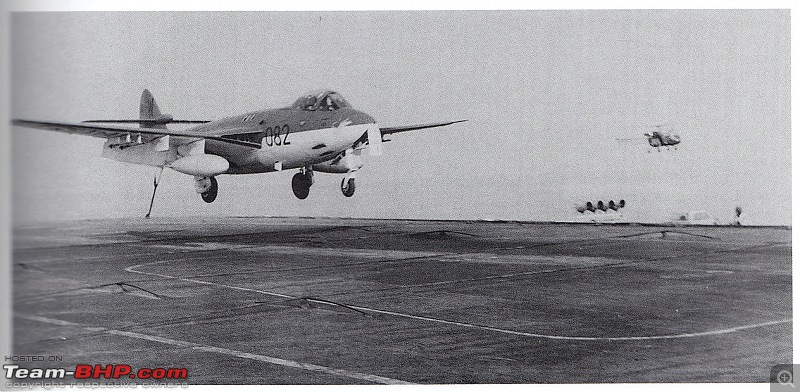 P12. Seahawk coming into a precision deck landing. Arrestor hook extended down to snag one of the 3 wires strung across the width of the deck. Wires as you see are slightly raised to facilitate hooking. Note the flaps are down for landing but the engine is actually revved up to full throttle at this moment to enable a bolt and take off if the hook doesn't snag. Like driving with full accelerator and half brakes so that you can zoom of in an instant if needed by releasing the brakes! The carrier is steaming at ~23 knots and pitching and rolling and moving away from the aircraft all the time. Rescue helicopter on the flanks in case of... Source $$ 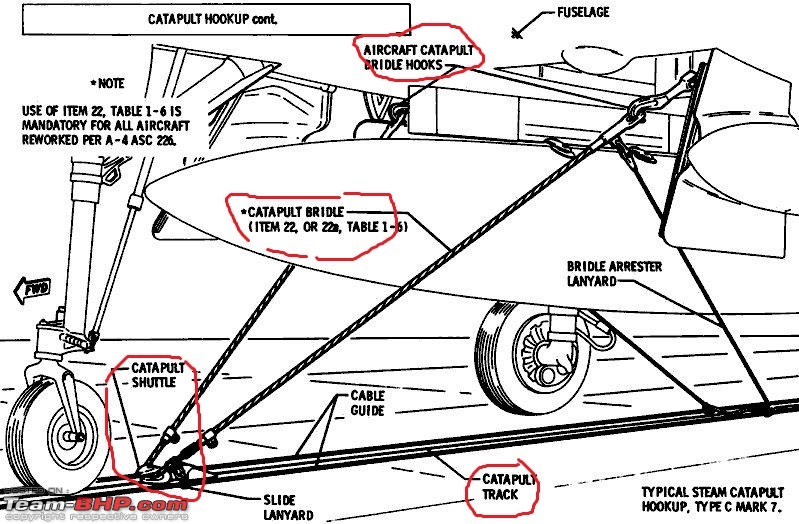 P12a. Diagram depicting how the bridle ( V shaped wire) is attached to the aircraft and is pulled along by the catapult shuttle which runs in the catapult track (a groove in the steel deck) driven by the piston below deck. The piston is propelled forward by an explosive injection of high pressure super heated steam.  P13. Seahawk being aligned on the steam catapult which runs under the railing groove in the deck (long black line) on the left. The Flight Deck Officer (with flags) controls the movement with flags and radio. A second Seahawk is positioned to be catapulted as soon as the first one goes. The catapult accelerates the Seahawk to 120 knots in about 200 feet reaching ~ 6G. Source $ ….Taking Off from a carrier For every take off the ship would steam into the wind at full speed to have a strong wind over deck to aid the take off. The aircraft is literally catapulted off the deck very much like a child's catapult. The catapult is a piston running in a groove under deck fired by high pressure steam. The piston is attached to the aircraft through a bridle wire and a catapult shuttle. See photo P12a depicting how the bridle ( V shaped wire) is attached to the aircraft and is pulled along by the catapult shuttle which runs in the catapult track (a groove in the steel deck) driven by the piston below deck. The piston is propelled forward by an explosive injection of high pressure super heated steam. Once ready for launch, the pilot will apply full throttle, the aircraft will be held in place by restraints and then the high pressure steam is fired into the catapult cavity driving the piston forward and flinging the aircraft into the air at ~120 knots (207 kmph) in just 200 feet and a little over 1 second. How's that for acceleration. I have put this in very brief form. Actually it is a complex operation involving about 30 crew in various roles. Seahawk pilots and Vikrant's deck crew were trained to launch an aircraft every 36 seconds. Photos P13 and P14 show the take-off and P15 shows the aircraft the instant it has got off the deck In May 1976 a most unusual incident took place - the deepest underwater ejection by a pilot anywhere in the world. Commander Peter Debrass was readying for a regular sortie. His Seahawk was hooked onto the catapult with his engines on full power. At launch the bridle most unusually fell denying the Seahawk the kinetic energy of the catapult while its engines on full started rolling it forward at a high speed but not high enough for a takeoff. All of this happened in the space of 2 seconds and the aircraft simply toppled off the edge of INS Vikrant and the ship ploughed over the machine. Peter Debrass kept his cool even as the machine sank rapidly and water filled his cockpit. The alert Captain ordered the ships propellers to be reversed immediately so that instead of being sucked into the giant propellers and getting killed, Debrass if he got out, would be thrown away from the ship by the forward thrust of the propellers. That action saved the pilots life. Debrass let the aircraft sink till he felt the carrier had passed over and then fired his ejector seat and with some difficulty surfaced and was rescued by the Alouette helicopter. The time elapsed from catapult failure to being hauled into the rescue helicopter was less than 3 minutes. He ejected from somewhere between 30 to 50 feet underwater. Martin Baker the makers of the ejection seat stated this was perhaps the deepest underwater ejection ever. Over its life INS Vikrant conducted well over 10,000 catapult launches and this was almost the only launch accident of this magnitude.Source $$ P12. Seahawk coming into a precision deck landing. Arrestor hook extended down to snag one of the 3 wires strung across the width of the deck. Wires as you see are slightly raised to facilitate hooking. Note the flaps are down for landing but the engine is actually revved up to full throttle at this moment to enable a bolt and take off if the hook doesn't snag. Like driving with full accelerator and half brakes so that you can zoom of in an instant if needed by releasing the brakes! The carrier is steaming at ~23 knots and pitching and rolling and moving away from the aircraft all the time. Rescue helicopter on the flanks in case of... Source $$  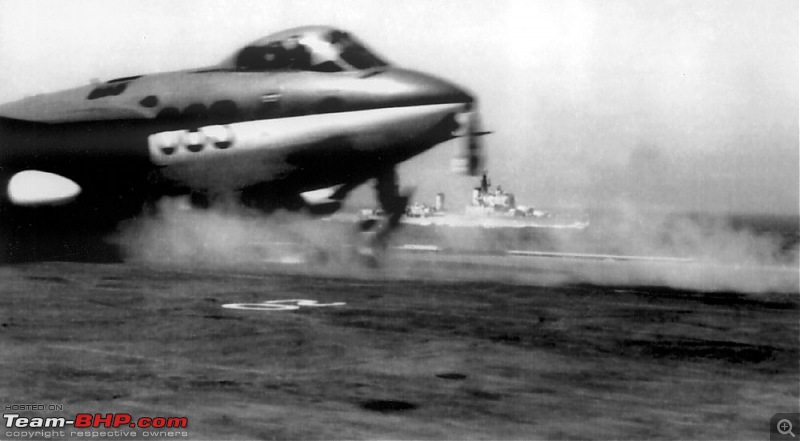 P14. Seahawk taught at the steam catapult with steam at full pressure, engines at full thrust and brakes which were at full on having just been released a fraction of a second ago. The aircraft gets catapulted off the ship in a second from brakes release to off the deck. Source $$ 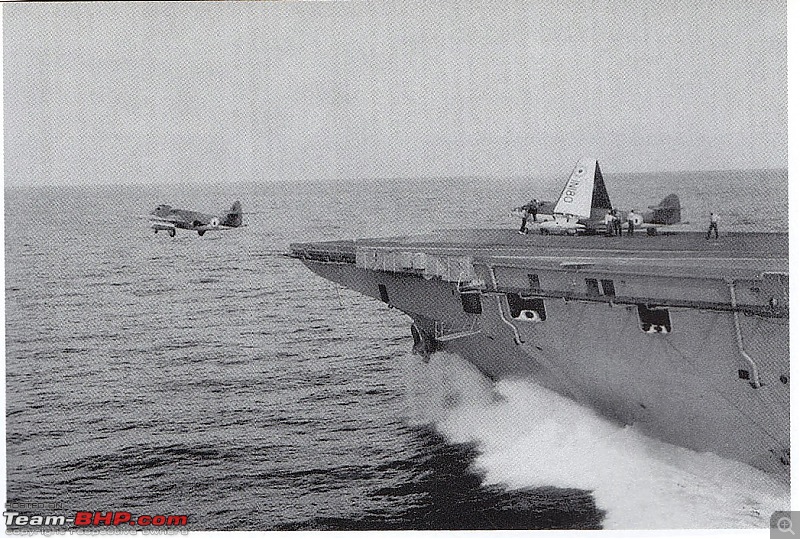 P15. A fraction of a second after launch, the landing gear has just started retracting, the aircraft is barely 32 feet above the water and starts to build airspeed and about a second later climbs away. Note the sharpness of the bow (front nose) of the ship ploughing through the sea at full speed. Source $$ VI. 1971 war Source $$ and ## The Seahawks did not get a role to play in the 1962 aggression by China mainly because the political and civil leadership of the country were confused and paralyzed and wrongly (in my opinion) chose not to use any air power at all leaving the Army without vital air cover and losing the opportunity of severing the fragile Chinese lines of supply. The 1965 aggression by Pakistan found INS Vikrant in dry dock undergoing as refit. The Seahawks were deployed to provide for the air defence of Mumbai but it still did not get them blooded. The opportunity came in December 1971 when the PAF (Pakistan Air Force) on 3rd December 1971 tried to emulate the Israelis with a pre-emptive strike on IAF (Indian Air Force) airfields. But the Pakistanis were not in the same league as the Israelis and the IAF was certainly not the Egyptian or Syrian Air Force! The Pakistani Navy was eager to know the whereabouts of INS Vikrant and determined to sink her with a submarine the PNS Ghazi which was sent expressly, to Vizag, for this purpose. They assumed INS Vikrant was at Vizag on India's Eastern seaboard by reading radio signals being exchanged on Indian frequencies that indicated a very large warship at Vizag was preparing to sail and was busy taking on aviation fuel, food and aircraft ammunition. In 1971 amongst all Asian countries such signals could mean only one ship. But in reality INS Vikrant had long sailed to the Andaman's and then steamed up the isolated Andaman Sea to position herself south of East Pakistan in total radio silence. The Indian Navy's simple deception, the oldest ruse in the Signals' book, had worked like a charm. PNS Ghazi on the other hand sank off the coast of Vizag (that is another story). From 4th December onwards the Seahawks along with their stable mates the Breguet Alize attacked Pakistani naval, oil and harbour installations and completely blockaded any ship attempting to escape from East Pakistan. The Seahawks over 10 days mounted 160 ground attack sorties on the ports of Chittagong, Khulna, Mongla and Chaina. They attacked and disabled the main airfield at Cox's Bazar and the airport at Chittagong cratering the runways and destroying the control towers and other facilities. Through this the Seahawks prevented the PAF from using these airstrips thus protecting themselves from Pakistani Sabre's. They attacked ships and barges carrying enemy troops and ammunition. Dozens of small and medium merchant ships, barges, coastal vessels and two Pakistani Navy gun boats were sunk thus making the Pakistani commander Lieutenant General Niazi realize that escape or re-supply southwards via the sea was not an option and with the Indian Army speeding in on the other three sides surrender was a sensible alternative. The Seahawks operated with no loss though they faced ground based anti-aircraft fire on all missions. Six Seahawks suffered some damage but all made it back to INS Vikrant. Typical ammunition types deployed were 500 lbs (227 kgs) bombs, 127mm rockets and the ubiquitous 20mm cannon shells. This was the first and last combat record of the Seahawks in Indian Naval service and the aircraft, its pilots, the maintenance engineers and the ground crew acquitted themselves with fine honour. INS Vikrant in December 1971 was commanded by Capt. Swaraj Prakash who displayed exceptional calm and clear thinking in the heat of battle. The White Tigers were commanded by Lieutenant Commander SK Gupta. Both Prakash and Gupta were awarded the Maha Vir Chakra. Photo P20 shows some of the young and valiant crew soon after the conflict. Photo P21 is the roll of honour for those who fought and won. INS Vikrant and its aircraft were tasked to neutralize enemy shipping and shore facilities, prevent Pakistani forces from being re-inforced or evacuated by sea and counter any attempt by a third country from interfering. The ship and her aircraft delivered effectively on all three. This was their finest hour. 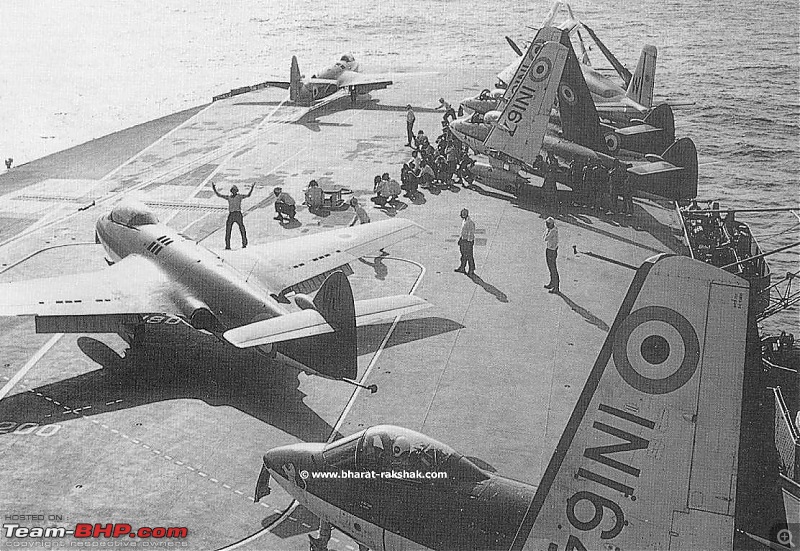 . Dec'71 off East Pakistan. One Seahawk taking off with aid of steam catapult. Second awaiting its turn. Note how tight the squeeze is between the wing tip of the aircraft taking off and those parked on the foredeck Source $$ 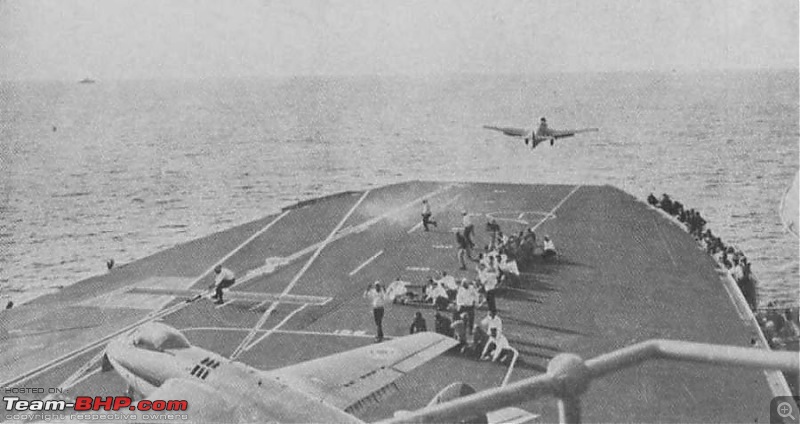 Dec'71 Seahawk just launched beginning its climb fully armed for attack on Chittagong harbour, East Pakistan. The steam is still evaporating from the catapult rail Source $$ 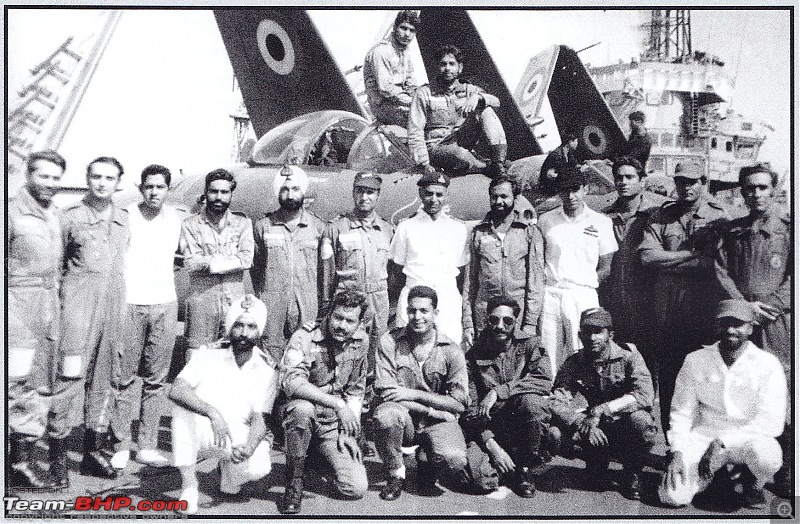 Some of the pilots and crew of the White Tigers soon after end of hostilities in December 1971. In the centre, standing in whites is Captain Swaraj Prakash the commanding officer of Vikrant in the 1971 operations. On his right is Lieutenant Commander SK Gupta who led INAS 300. Both received the Maha Vir Chakra medal. In front of Capt Prakash, kneeling, is Lieutenant Commander Vinod Pasricha who later became the first Captain of INS Viraat (our 2nd aircraft carrier) and wrote the book Down Wind, Four Green which is the definitive book on the Sea Hawk in India. Source $$ 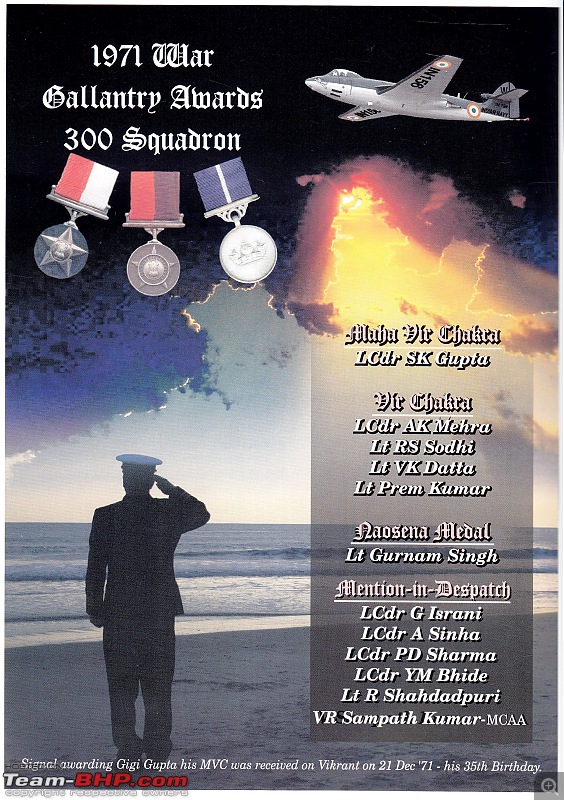 Gallantry awards to INAS 300 White Tigers. Source $$ http://www.bharat-rakshak.com/NAVY/H...leet-1971.html VII. Issues & challenges of maintenance and obsolescence Source $$ The Seahawks started entering service with the IN only a few years before they were phased out by the other three users - Britain, Netherlands and West Germany. And most of our machines were second hand refurbished ones. Over the years maintenance troubles multiplied caused by age and the high ambient temperatures in Indian waters. Some of these were with troublesome fuel tanks especially the centre one which saddled the engine, hydraulic leaks, strain on the landing gears as age caught on and hairline cracks in the engine jet exhausts. The tenacity and sweat and innovativeness of the aircraft maintenance crew kept these machines operational till 1978. By then not only were the airframes long on hours but availability of spares was a challenge and some Seahawks were cannibalized to keep a core flying. VIII. Phasing out & conclusions The Seahawk and all those who served in INAS 300 and on INS Vikrant in the 1960s and 1970s allowed India to first build and then retain the complex skill of operating an aircraft carrier and launching & retrieving combat aircraft from it. By then several other nations who once operated aircraft carriers dropped out from the club either for reasons of revised naval strategy like the Netherlands or for reasons of cost like Australia, Canada & Argentina. It was clear by the early 1970s that a replacement was essential if we were to retain our hard won, battle tested carrier capabilities. Fortunately for India the UK were investing in 3 light carriers designed for operating the vertical take off and landing Harrier and were developing a dedicated sea going version which entered service with the Royal Navy in 1979. India was the first to place an order, in 1979, for this revolutionary and (till today) unique aircraft. The Hawker Harrier become the worthy and much superior successor of the Hawker Seahawk. When the first Sea Harriers flew into India on their delivery flight the last fly worthy Seahawk of the Indian Navy flew out to welcome them and for a brief time old and new flew in formation on 16th December 1983. That was the last operational sortie by a Seahawk. That particular machine was later gifted to the German Navy, repainted in German colours and placed in a museum (PS: we had originally bought it from the Germans!). The Harrier operated from a refurbished and increasingly aged INS Vikrant from 1983 to 1994 and on aboard INS Viraat from 1987 to date. That the IN had to soldier on with a useful but obsolescent aircraft for 8 to 10 years longer than what would normally be expected was a function of India's non-aligned status in days of the cold war, India's then shortage of foreign exchange resources and INS Vikrant's short stroke catapult. It is to the credit of the pilots and ground crews who kept a vital skill and deterrent capability alive and effective despite limited national resources. INS Vikrant received two long refits to keep the ageing lady operational and she sailed till 1994 after which she went into reserve and was decommissioned in 1997. One sole Seahawk in the UK continues to fly at air shows. 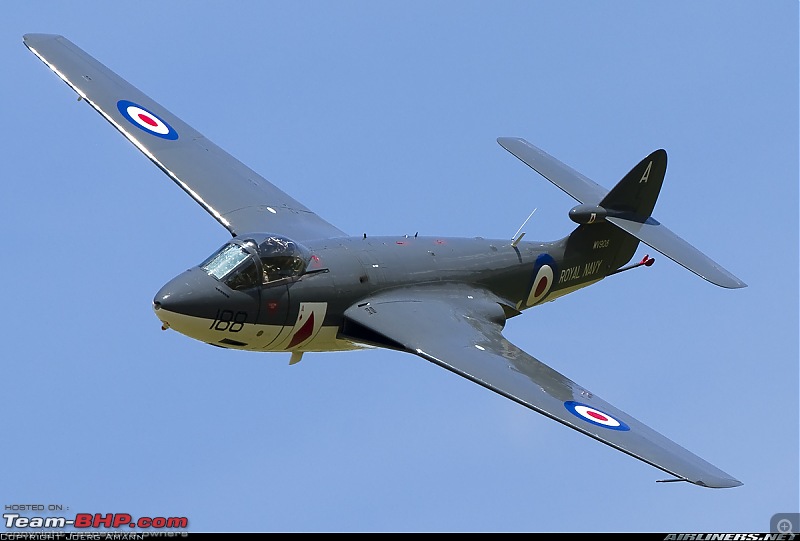 Last Seahawk in flying condition. Based in the UK. Performance at air shows occasionally. Note its immaculate maintenance 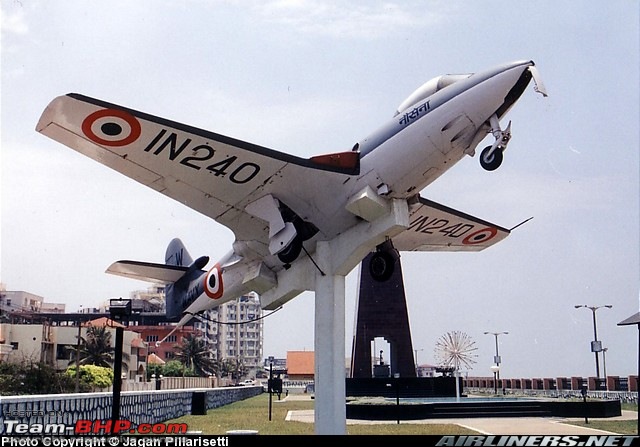 Seahawk airframe on display on Beach Road, Vizag. A well kept one (thankfully) 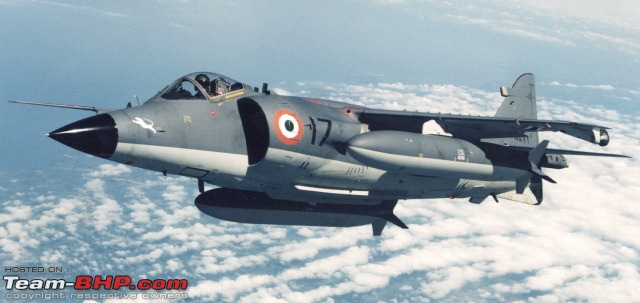 The Sea Harrier vertical take off and landing jump jet - the Seahawk's successor which joined the Navy in 1983 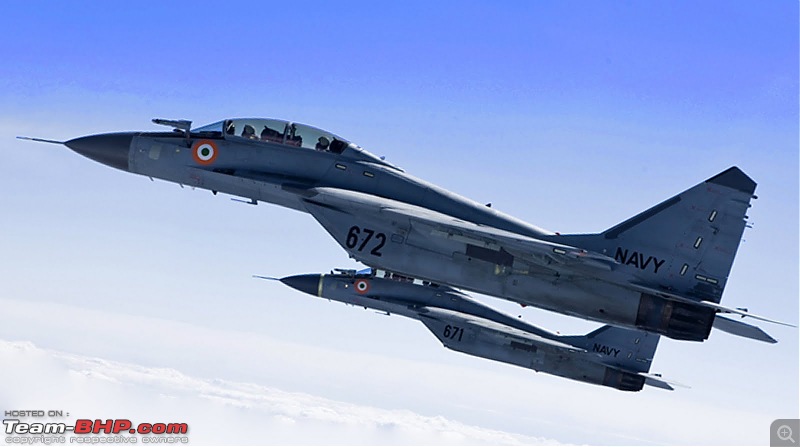 The Mig-29K multi-role combat aircraft, successor to the Harrier. The result of seeds sown half a century earlier. IX. References Transition to Triumph, Indian Navy 1965 to 1975 by Vice Admiral GM Hiranandani; Lancer Publications, 2000 (part of the official history of the Indian Navy) Downwind, Four Green by Vice Admiral Vinod Pasricha; Pashmira publications 2010 ( www.pashmira.com ) 'Fly Navy', An Illustrated History of Naval Aviation by Pushpinder Singh; The Society for Aerospace Studies, 2006 Carrier Aviation, Air Power Directory; AIR Time Publishing 2001 The Encyclopedia of World Sea Power by Chris Bishop; Aerospace Publishing Ltd, 1988 X. Source & copyrights of photos & anecdotes $$ - Down Wind, Four Green by Vice Admiral Vinod Pasricha ## - 'Fly Navy', An Illustrated History of Naval Aviation by Pushpinder Singh Other sources mentioned, where known, alongside photograph Last edited by ajmat : 21st November 2014 at 11:27. |
| |  (83)
Thanks (83)
Thanks
 |
| The following 83 BHPians Thank V.Narayan for this useful post: | abishek2222, adrian, ajmat, Akshay1234, amitkb, amit_purohit20, amoi, anshuman_v, arnabchak, arpanjha, arunphilip, Ashley2, ashpalio, audioholic, Automaton, bblost, Blueleader, BopsKA12, CliffHanger, darklord, dhanushmenon, Diesel_convert, directinjection, DrPriyankT, FlyingSpur, Foxbat, GTO, himanshugoswami, honeybee, ike, Insearch, ir458, jalsa777, Jeash.vk, joednazareth, joe_antony, john doe, JoseVijay, karlosdeville, khoj, KPS, kutts, libranof1987, LordSharan, mac187, Manas, mh09ad5578, mi2n, mpksuhas, Naztone, neerajdan, nitinralli, PapaBravo, paragsachania, parsh, phamilyman, predatorwheelz, procrj, R2D2, revintup, rjstyles69, rxpaul, sadnabrina, samabhi, SamarthMehrotra, shobhit.shri, Shreyans_Jain, shubhamAT, silversteed, skanchan95, spdfreak, SR71-Blackbird, sridhar-v, SS-Traveller, Starfire, Swerve, swiftnfurious, theexperthand, travancore, Twinn, vaasu, voyageur, whitewing |
| |
| | #2 |
| Team-BHP Support  | Re: Indian Aviation - Hawker Seahawk with the Indian Navy Note from Mod Pics added and moving into general forum Thanks for sharing |
| |  ()
Thanks ()
Thanks
 |
| | #4 |
| Distinguished - BHPian  Join Date: Apr 2011 Location: KL-2/KL-7/GA-06
Posts: 1,109
Thanked: 4,346 Times
| Re: Indian Aviation - Hawker Seahawk with the Indian Navy Awesome thread sir. Though I knew about (Ex) INS Vikrant, the back ground story behind its materialization into the Indian Navy was an eye opener. What was more delightful was the effort in bringing to the glory the past of Seahawks, the first of white tigers. Days had gracefully flown by and it's the MiG 29Ks which is the flagship these days under the banner of "Black Panthers". Being in the field of aviation, your love for aircraft carriers is quite comprehend able. The passion with which you described the carrier and its days clearly showed how close you keep her to your heart. However, I am of the opinion that its not aircraft carriers that we need now, but potent and lethal submarines. Well, that's just my opinion and this debate has always been a ripe fruit. Last edited by dhanushmenon : 21st November 2014 at 16:01. |
| |  (1)
Thanks (1)
Thanks
 |
| The following BHPian Thanks dhanushmenon for this useful post: | GTO |
| | #5 |
| Senior - BHPian | Re: Indian Aviation - Hawker Seahawk with the Indian Navy Seahawk on Beach Road in Vizag perished during the recent cyclone (HudHud). |
| |  (2)
Thanks (2)
Thanks
 |
| The following 2 BHPians Thank hillram for this useful post: | dhanushmenon, joednazareth |
| | #6 |
| BHPian Join Date: Jul 2009 Location: Mangalore/Bangalore
Posts: 330
Thanked: 91 Times
| Re: Indian Aviation - Hawker Seahawk with the Indian Navy Great read. Thanks for sharing. Just to add to the first post. Pakistan surrendered couple of days after the bombing on December 4th (also known as Operation trident) and ever since December 4th is celebrated as Navy day in India. Those of you interested can google operation trident or the sinking of PNS Ghazi. It is a great read which gives you a proud feeling  |
| |  ()
Thanks ()
Thanks
 |
| | #7 |
| Distinguished - BHPian  | Re: Indian Aviation - Hawker Seahawk with the Indian Navy Thank you Mr. Narayan for this wonderful write up, it was a very interesting read. Kudo's to our navy, imagine only one accident even though the equipment was aging. The presence of mind displayed by the Captain and Pilot during the accident in 1976 and the subsequent rescue in 3 minutes was amazing. I wonder what is the "G" Force when landing? cheers KPS |
| |  ()
Thanks ()
Thanks
 |
| | #8 |
| BHPian Join Date: Sep 2014 Location: New Delhi
Posts: 223
Thanked: 853 Times
| Re: Indian Aviation - Hawker Seahawk with the Indian Navy On a related note. The glorious warship in these pictures in being broken up as we read at Darukhana in Mumbai. The pictures are heartbreaking, especially since she was such a dignified lady. But as they say the spirit carries on. |
| |  (1)
Thanks (1)
Thanks
 |
| The following BHPian Thanks shady_lawyer for this useful post: | john doe |
| | #9 | |
| Distinguished - BHPian  Join Date: Apr 2011 Location: KL-2/KL-7/GA-06
Posts: 1,109
Thanked: 4,346 Times
| Quote:
Yes. That's correct. The ship is being broken up. The ship served some time as a museum at the Naval Dockyard in Mumbai. However, as time passed, the grand lady got more and more expensive for the Navy to maintain. The withering structures and corroded hull also supplemented its pain. There was a thought for a while to preserve the ship in some place as a floating/grounded restaurant in the middle of the bay. However, that also got shelved off. Later, the carrier was sold to a businessman who is presently breaking her up | |
| |  ()
Thanks ()
Thanks
 |
| | #10 |
| BHPian Join Date: Nov 2010 Location: India
Posts: 124
Thanked: 59 Times
| Re: Indian Aviation - Hawker Seahawk with the Indian Navy Nicely written article. Kudos. Being a fighter pilot myself and flown various types of fighter jets in air force, I can tell you that being a naval aviator is the pinnacle of human evolution. That's why they say "The three best things in life are a good landing, a good orgasm, and a good bowel movement. The night carrier landing is one of the few opportunities in life to experience all three at the same time." Cheers |
| |  (13)
Thanks (13)
Thanks
 |
| The following 13 BHPians Thank sheelz for this useful post: | adg_andy, arnabchak, arunphilip, ashpalio, Automaton, blackwasp, darklord, joednazareth, john doe, Srikanthan, TheLizardKing, TheStig, V.Narayan |
| | #11 | |
| BHPian Join Date: May 2011 Location: India
Posts: 333
Thanked: 300 Times
| Re: Indian Aviation - Hawker Seahawk with the Indian Navy Quote:
If you are a current IAF pilot, can you tell me something? Do you pilots get issued Ray-Bans or equivalent aviator shades by the IAF? And how about watches: so many of us civilians wear the huge dialed, multi-hands, multi dials pilot chronograph types, do you wear or even need the same watches? Caveat: If you bother answering the above , a dam of additonal questions will burst from the innermost recesses of my brain  Thanks!! | |
| |  (1)
Thanks (1)
Thanks
 |
| The following BHPian Thanks john doe for this useful post: | jalsa777 |
| |
| | #12 |
| BHPian Join Date: Nov 2010 Location: India
Posts: 124
Thanked: 59 Times
| Re: Indian Aviation - Hawker Seahawk with the Indian Navy Yes we are issued with Ray Ban aviators, black shades. Yes we do wear watches. I use Casio protrek prt-80 |
| |  (3)
Thanks (3)
Thanks
 |
| The following 3 BHPians Thank sheelz for this useful post: | arpanjha, jalsa777, john doe |
| | #13 |
| BHPian Join Date: Aug 2009 Location: All CAPS
Posts: 485
Thanked: 248 Times
| Re: Indian Aviation - Hawker Seahawk with the Indian Navy Amazing Sir, a goldmine of rare info!! I always thought the R11 Vikrant was a ski jump type (STOBAR?) but it seems from the above that it was indeed a true blue CATOBAR.... wonder what Vikrant's second avatar is going to be like, which is due for commissiong some time in 2018. |
| |  ()
Thanks ()
Thanks
 |
| | #14 | |
| Distinguished - BHPian  Join Date: Apr 2011 Location: KL-2/KL-7/GA-06
Posts: 1,109
Thanked: 4,346 Times
| Quote:
The new avatar is gonna be STOBAR. I am not sure of the commissioning date though. | |
| |  ()
Thanks ()
Thanks
 |
| | #15 |
| Distinguished - BHPian  Join Date: Apr 2011 Location: KL-2/KL-7/GA-06
Posts: 1,109
Thanked: 4,346 Times
| Just saw this and thought it was relevant on this thread. http://m.indiatoday.in/story/indias-.../1/403180.html |
| |  ()
Thanks ()
Thanks
 |
 |


